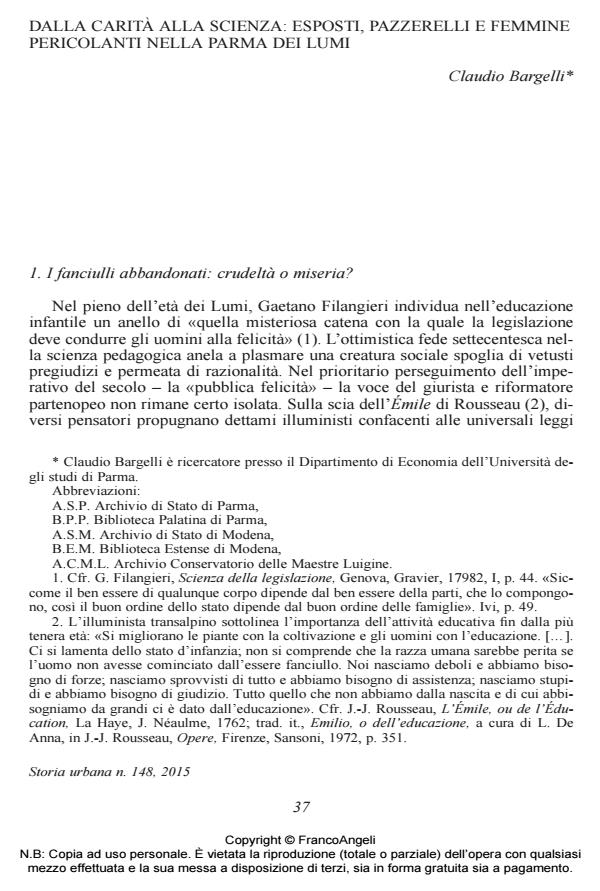From charity to science: foundling, crazies and girls in moral danger in Parma in the Age of Enlightment
Journal title STORIA URBANA
Author/s Claudio Bargelli
Publishing Year 2016 Issue 2015/148
Language Italian Pages 40 P. 37-76 File size 785 KB
DOI 10.3280/SU2015-148002
DOI is like a bar code for intellectual property: to have more infomation
click here
Below, you can see the article first page
If you want to buy this article in PDF format, you can do it, following the instructions to buy download credits

FrancoAngeli is member of Publishers International Linking Association, Inc (PILA), a not-for-profit association which run the CrossRef service enabling links to and from online scholarly content.
During the Age of Enlightenment, the worsening of the thorny issue of begging and the associated emergence of rising social needs nourish the sprouting of specific institutions, as significant reflection of the growing articulation of charitable offer. The progressive recognition of new forms of poverty with their own identity and distinct prerogatives involves the complete awareness of the many aspects of deviance, to which the good order of society requires appropriate answers even at the institutional level. In the duchy of Parma, an important role has to be acknowledged to the French Minister Du Tillot, whose incisive reformist programs operate in the wake of the Eighteenth-century welfare thought. The optimistic faith of the Enlightenment in the pedagogical science establishes the emergence of a new feeling towards childhood. Between the Eighteenth and Nineteenth centuries we are witnessing the attenuation of the infant and child mortality within the citizen orphanage, as well as the distinction between the different forms of diseases, providing, for the first time, the large class of different mental diseases with an independent identity. The primary pursuit of "public happiness" requires a thorough social hygiene, by eliminating from the city the destabilizing crowd of crazies and conveying it in appropriate places of refuge, offering not only mere custody but, rather, appropriate therapies. Evidence of this trend is the exponential growth, in the second half of the Eighteenth century, of the number of crazies received at the Hospital of Mercy of Parma. The Eighteenth century appears as a watershed also in another matter. By passing through the narrow boundaries of the noble and cloistered fences, the female figure acquires renewed importance. An important role in this respect have the Eighteenth-century boardingschools for girls, aimed at hosting the girls in moral danger, educating them in learning a trade. Of no less interest, finally, is the accounting of Pia Loca, with particular reference to the Eighteenth century. From the annual reports of the Hospital of Mercy emerges the wide predominance of internal management expenses: outflows linked to food, medical care and, to a lesser extent, financial charges and disbursements related to the maintenance of buildings and farms. An analysis of the various items of expenditure shows a slow improvement in the diet, with a growing weight of beef to the detriment of the secular dominance of carbohydrates, as well as a prudent and profitable management of estate land.
Keywords: Duchy of Parma Italy XVIIIth century -Pauperism "Girls in danger "
Claudio Bargelli, Dalla carità alla scienza: esposti, pazzerelli e femmine pericolanti nella Parma dei Lumi in "STORIA URBANA " 148/2015, pp 37-76, DOI: 10.3280/SU2015-148002